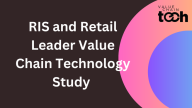Supply Chain Focuses on Logistics and Operations, Value Chain Delves into Customer Value
In an inflationary economy, higher business costs necessitate the alignment between functions not only within the retailer, but also with partners, supplies and customers. As an evolution of the supply chain function from cost-center to value-creator, value chain describes the scope of activities that organizations perform to bring a product or service from conception to its use and beyond. With the sustained growth of global commerce, the term global value chain is also interchangeably used.
Supply chain evolution
Michael Porter coined the term “value chain” in 1985 as a tool to improve competitiveness by analyzing and integrating entities, processes and people involved in imparting and delivering value to customers across nine interdependent activities:
- Infrastructure
- Human resources management
- Technology development
- Procurement
- Inbound logistics
- Operations
- Outbound logistics
- Marketing and sales
- Service
Since then, the value chain has evolved to organize functions under categories such as value adding, i.e., R&D and new product introduction. Additionally, value chain can include supply chain-related logistics and warehousing along with support, such as technology and consumer experience or customer relationship management.

Why value chain
Value chains aspire to steer resources to their most productive use, not only across countries and sectors, but also within the stages of value addition. Consequently, hyper-specialization assumes significant importance along with the coordination needed to achieve the flow of material and information. While international trade traditionally involves movement of products between two countries, global value chains entails spatially dispersed production activities spanning multiple countries, occasionally back and forth.
This necessitates the creation of a boundaryless organization with cross-functional integration, team alignment and a strategic focus on customer value. A value chain assessment involves two major activities:
1.Value chain mapping: Identifying the firms, products, activities, stakeholders and geographic locations involved in taking a good or service from concept through production to the final consumer.
2. Value chain analysis: Looking at how and why these factors are linked together by analyzing the role certain factors, such as governance, institutions and interfirm relationships, play in influencing the location, development, and competitiveness of a product or service.
A value chain and a supply chain are closely related, functioning in tandem within a business ecosystem. While a supply chain focuses on the logistics and operational processes from raw materials to the end product, the value chain delves into how these steps contribute to the creation of customer value. In essence, the value chain encapsulates the supply chain, using it as a tool to increase a product's value, thereby increasing competitive advantage. While supply chain mapping and analysis is typically conducted within the boundaries of supply chain, extending it to other aspects of the business and stakeholders will interlink the two. Recognizing the interconnection between the two enables businesses to operate more effectively, with an integrated approach to maximizing value at each step.
Enablers of value chain
In the past two decades, the value chain has been enabled by affordable and reliable communication, economies of scale lowering transportation costs and technology aiding coordination among geographically diverse stakeholders. Weakening trade barriers, trust driven strategic partnerships, heightened customer expectations and a recognition of core competencies among participants also contribute significantly to this growth

Still, the global value chain is riddled with successful advancements to benefit brands and retailers coupled with challenges. For example, Apple begins its value chain with insourcing of its marquee capability of design and R&D and adept management of an outsourced global supply network and contract manufacturers. Orchestrating the finished product supply chain to align with the release schedule and streamlining its omni-channel retail network to provide a unique shopping experience are key to its success. A critical element of its value chain is the software ecosystem that captivates its active customer base and drives revenue.
While Apple’s value chain is renowned, another venture for a global value chain that didn't work out as well and attracted a lot of negative attention was that of Boeing. Boeing ventured on a path-breaking philosophy for aircraft building for its 787 Dreamliner assembling a global team of risk-sharing partners. In addition to manufacturing, the partners had responsibility for engineering and design and delivering sub-assemblies to Boeing who would take on the role of an integrator. During the initial days, problems cropped up due to downstream issues, quality, timeliness and coordination causing significant delays in delivery of aircraft. It took significant restructuring of the value chain, including Boeing assuming responsibility for certain earlier outsourced capabilities, for it to succeed.
Looking ahead, successfully managing a value chain requires strategic planning and efficient execution as outlined here:
- Understand customer value and elements of the product or service that accentuate that value.
- Optimize each step of the value chain through mapping and analysis, leveraging technology and data, workforce upskilling and focus on efficiency.
- Create an environment that facilitates integration and coordination inline with the strategy.
This September 25-27, RL and RIS are joining forces to debut Value Chain Tech, a new event in Seattle focused on the technologies that power the key pillars of value chain success: agility, resiliency, collaboration and sustainability.

About the author
Ashok Viswanathan is Best Buy’s director of supply chain analytics and has more than 16 years' experience in driving supply chain transformation through innovative application of analytics and technology. Viswanathan leads a team of analytics professionals and product managers delivering solutions across transportation, warehousing, end-to-end network strategy and reverse supply chain. He has a PhD in industrial and systems engineering from Binghamton University, and is an adjunct faculty at Rutgers University, and speaks and publishes at various forums in the field of supply chain and analytics.
This story originally appeared on Retail Leader, a sister publication of RIS




